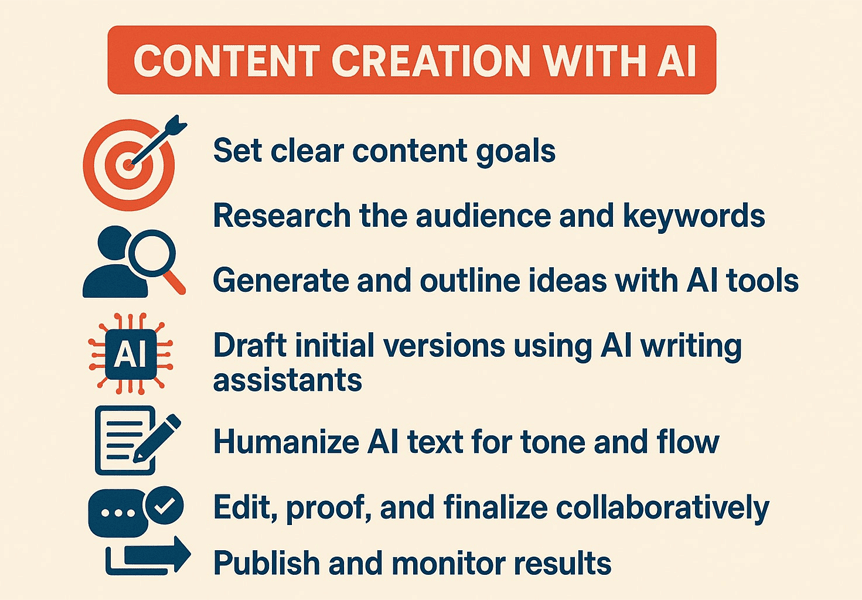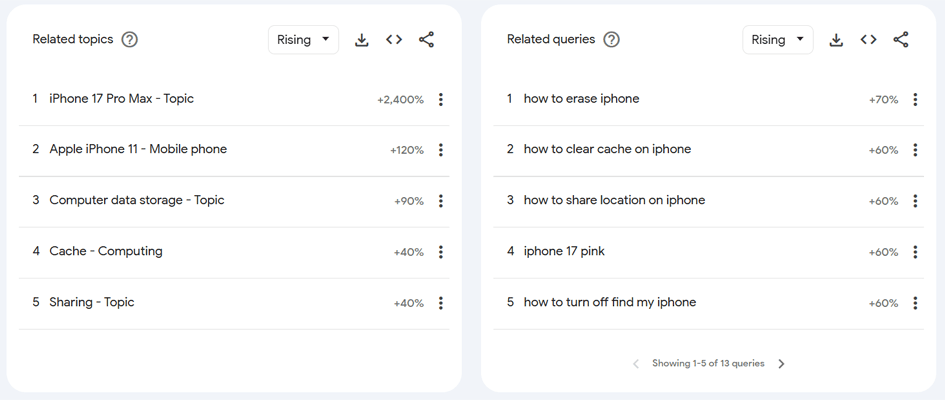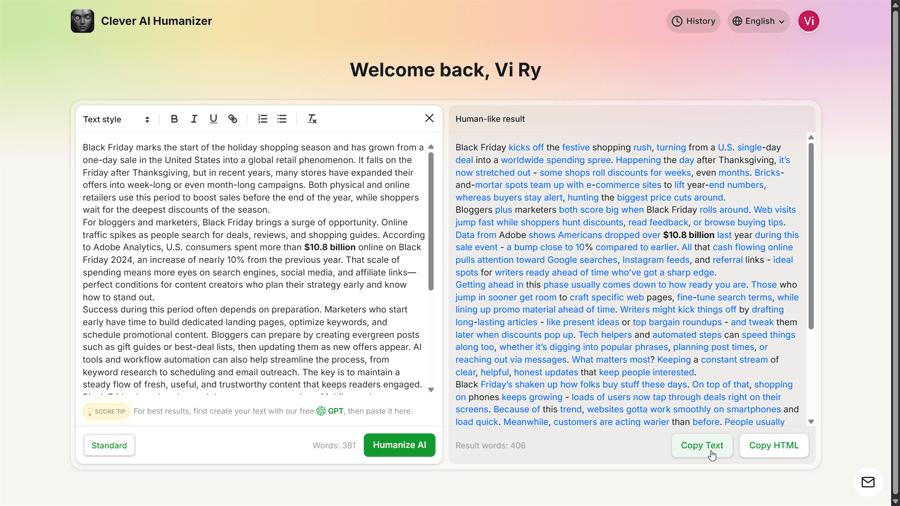Content creation often feels like a long race that never ends. Bloggers and marketers juggle ideas and edits while trying to keep quality high and publishing consistent. The pressure to deliver more content in less time makes it easy to lose focus and slip into repetitive work. A structured content workflow helps bring order to that routine. Modern tools, especially AI assistants and automation platforms, simplify many of the tasks that once drained creative energy. We will explain how to optimize the content creation flow with a clear plan and the right mix of AI and human input.
Table of Contents
Why Every Content Team Needs a Defined Creation Framework
Blog writing looks simple from the outside, but behind each post lies a chain of tasks that easily break down without structure. Missed briefs and rushed edits turn what should be a creative process into a cycle of delays. Modern blogging moves quickly, and teams that rely on ad-hoc methods struggle to keep up. The lack of clarity around roles and timelines makes it hard to plan ahead or stay consistent.
Readers also expect more variety and authenticity, which puts extra pressure on creators who already manage tight schedules.
The biggest challenges usually fall into three areas:
- Lack of time. Most creators spend too many hours on manual edits or reformatting instead of developing new ideas.
- Low productivity. A scattered process affects every part of the team. Writers work on drafts without clear briefs, editors receive inconsistent material, and marketers have to adjust campaigns last minute. When no one knows who owns each stage, projects stall and quality drops.
- Need for originality. Readers expect content that sounds natural, not generic or repetitive. Yet many teams rely on basic AI tools or templates that produce identical structures and phrasing. Without proper editing and human touch, content looks similar to everything else online.
A structured AI content workflow helps solve these issues before they appear. It maps each step and assigns clear roles to every contributor.
For example, AI writing assistants can generate outlines or initial drafts and AI humanizers can rewrite the text, making AI writing sound natural. Collaboration tools such as Notion or Trello help track each post’s progress, which makes deadlines visible and teamwork smoother. With this framework in place, marketers spend less time coordinating and more time writing.
7 Steps to Build an Optimized Content Creation Process
A strong content plan is the backbone of every successful blog or marketing strategy. It works as both a roadmap and a control panel, guiding topics, formats, deadlines, and distribution channels. When paired with a clear content workflow, it helps teams understand what needs to be written, when it should be published, and who is responsible for each step.
An AI content workflow automates early steps like topic generation and keyword clustering, while human editors refine the final tone and structure. This balance keeps creativity alive.
Below are seven steps that can help teams turn scattered effort into a consistent and scalable AI content workflow:
1. Set Clear Content Goals
Use the SMART framework to shape goals that are specific, measurable, achievable, relevant, and time-bound:
- Specific. Define what exactly needs to happen (e.g., increase blog visits).
- Measurable. Assign a number or target such as “gain 500 new visitors per month.”
- Achievable. Keep the target realistic for your team’s capacity and niche.
- Relevant. Align content with the brand’s wider marketing plan or campaign.
- Time-bound. Add a clear timeline, for instance, “reach this target within 3 months.”
You can create a content performance dashboard in Notion or other productivity tools for marketers to track metrics such as page views and conversion rates. It’s also a great idea to hold short planning sessions where writers, editors, and marketers agree on one primary KPI per article before production begins.
Once clear goals are in place, the rest of the AI content workflow naturally aligns to meet them.
2. Research the Audience and Keywords
A successful content creation process depends on how well you understand the people you write for. Audience and keyword research shape every creative decision. When creators skip this step, posts often miss search intent or fail to connect with readers on a personal level. You should identify who reads your blog and what problems they want to solve. Check which posts get the most engagement and how readers respond in comments or social channels.
Once you know your audience, move to keyword research. Keywords define how your audience finds you. You can use Google Keyword Planner or Ahrefs Keywords Explorer to identify medium-difficulty keywords with clear intent. Explore the “People also ask” and “Related searches” sections in Google to gather question-based keywords for subheadings.
Track seasonal or trending topics using Google Trends to plan timely posts.
3. Generate and Organize Ideas
Once goals and audience insights are clear, it’s time to fill your content pipeline with ideas that actually fit your readers’ interests and business objectives. Set up a central idea hub, a single place where all team members can drop thoughts, outlines, and keyword-based suggestions. This prevents confusion and keeps old ideas from getting lost in long chat threads or email chains. Tools such as Notion or Airtable help categorize topics by stage: idea, outline, draft, ready to publish.
Here are some techniques to organize and prioritize ideas:
- Score topics by relevance, keyword potential, and alignment with business goals using a simple 1-5 rating system.
- Tag ideas by content type (how-to, case study, tutorial, trend analysis) and stage of the funnel (awareness, consideration, decision).
- Set deadlines and assign ownership for each idea directly in your project management tool.
- Use a content calendar in ClickUp or CoSchedule to visualize what’s planned, in progress, and ready for publication.
Once ideas start piling up, organization becomes as important as generation. Sorting and ranking them by potential impact keeps your workflow clear.
4. Draft Using AI Writing Assistants
Writing the first draft often takes more time than expected. AI writing assistants help shorten this stage by generating outlines and first drafts. Define your post’s purpose, audience, and key points from the research stage. This makes AI output more relevant and easier to refine later. Tools such as ChatGPT or Copy.ai can expand bullet points into coherent paragraphs, generate alternative introductions, boost content writing efficiency, or rewrite sections for clarity.
Feed the AI an outline with clear headings and let it fill in paragraphs for each part. For example: “Write a 100-word section about the importance of keyword consistency in a blog post.” Paste parts of reference material and ask the AI to condense them into short, readable explanations. Request two or three options for key paragraphs or introductions, then combine the best lines manually.
5. Humanize AI Text with an Online Tools
AI writing assistants make drafting fast, but raw AI text often lacks voice and nuance. Readers can sense when something feels robotic or overly polished. The solution is to humanize it. Humanization means more than fixing grammar. It adds rhythm, variation, and personal touch.
If you need a free online tool that handles longer texts, we recommend a free ChatGPT humanizer. Clever AI Humanizer supports up to 4,000 words per run and offers a generous free plan covering up to ~120,000 words per month, depending on usage.
Here’s how to use it:
- Copy the draft generated by your AI writing tool and paste it into the text box.
- Click “Humanize Text.”
- Read through the processed version.
- When satisfied, click “Copy Text” and paste the new version into your preferred editor.
The process is fast and requires no technical setup, which makes it ideal for bloggers, marketers, and small teams focused on publishing high-quality content at scale.
If you’re looking for a way to make AI text sound more human naturally and reduce the chances of it being flagged by AI detectors, tools like Clever AI Humanizer can help. They smooth out awkward phrasing and make your content feel more authentic – both to readers and search platforms.
6. Review and Collaborate
Editing should be a shared process, not an afterthought. Use cloud-based editors like Google Docs for comments and suggestions or Grammarly and Hemingway for grammar and readability checks. Apply your blog content strategy guidelines to maintain consistency across every post. Clear feedback loops between writers, editors, and marketers reduce back-and-forth revisions.
7. Publish and Track Performance
The last step of your content creation process should focus on measurement and reflection.
Schedule posts using tools like WordPress or Buffer, and monitor their performance through analytics dashboards. Measure views, reading time, and engagement to see which content format attracts more attention. Adjust topics and posting frequency based on this data rather than intuition. Over time, this cycle of analysis and refinement becomes the foundation for steady growth in both reach and quality.
Advanced Content Optimization Strategies
Once the basic workflow is in place, it’s worth mentioning a few strategies that, in our experience, help make the system sustainable. These advanced methods allow content teams to scale production, maintain originality, and make creative decisions backed by real performance data:
- One great method is content repurposing. A single in-depth article can become a set of shorter posts, infographics, newsletters, or videos. For example, a detailed guide can be reshaped into a quick checklist for LinkedIn and a short video summary for YouTube. This approach multiplies visibility without additional research time.
- Cross-platform adaptation also raises performance. Each platform favors a different tone and structure. LinkedIn prefers thought-driven insights, while Instagram benefits from visuals and concise captions. Rewrite content for each channel to reach wider audiences.
- Teams can also apply agile content methods. Break large campaigns into small, reviewable parts with clear deadlines. Weekly stand-ups or review checkpoints keep writers, editors, and SEO specialists synchronized. Collaboration tools such as Asana or ClickUp make task tracking transparent.
- Review and refine regularly. Every quarter, evaluate how well your workflow performs. Eliminate steps that add no value and test new AI tools that fit your needs. Continuous refinement helps your process stay adaptable as algorithms and reader expectations evolve.
These strategies help marketers and bloggers push beyond routine marketing automation. With the right balance between AI and human creativity, every post can move faster through the pipeline.
FAQ
What are the best AI tools for bloggers to streamline content creation?
Several AI tools can make the content creation process faster and more consistent. Jasper is ideal for long-form posts, while Writesonic combines writing and SEO optimization. Copy.ai helps with brainstorming headlines and short-form pieces, and Wordtune refines tone and clarity.
For research-driven blogs, Frase creates topic briefs and outlines. The best choice depends on your workflow. Teams often prefer Jasper or Frase, while solo bloggers lean toward Copy.ai or Wordtune.
How can marketers save time when producing blog content?
Marketers save time when each stage of the content creation process follows a clear structure. AI writing assistants handle first drafts or outlines, while shared tools like Notion or ClickUp keep tasks visible to everyone. Templates for briefs and outlines remove setup work, and tracking performance helps teams focus on topics that bring results. With consistent organization and clear responsibilities, less time is spent managing tasks and more on creating content that fits campaign goals.
How to make AI-generated text sound more natural?
AI text often feels stiff, but thoughtful editing makes it more human. Replace complex phrasing with simple words, vary sentence length, and avoid repeating ideas. Include contractions, idioms, and small examples to make writing sound conversational. Tools such as Wordtune or Clever AI Humanize refine tone and rhythm, while human editors make sure the final version matches your brand voice.
What are the key steps in optimizing a content creation workflow?
An AI content workflow moves through clear, repeatable stages. Start with goal setting, then research your audience and target keywords. Collect and organize ideas before drafting with AI tools to speed up production. Refine tone and flow through human editing, then review and measure performance. Tools such as Trello and Google Analytics keep each step organized.


